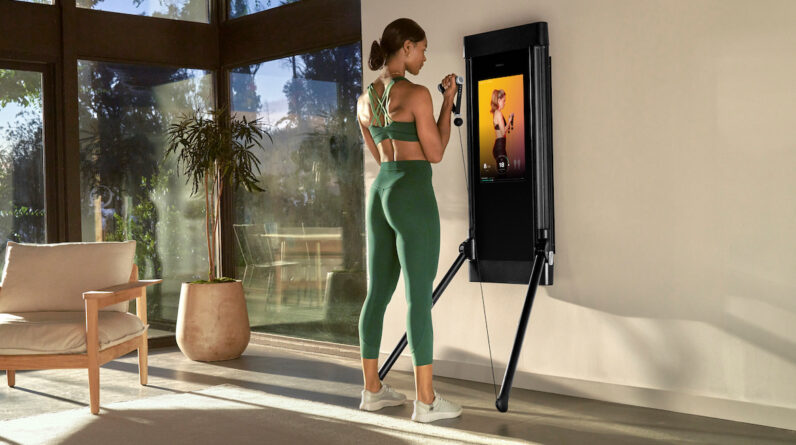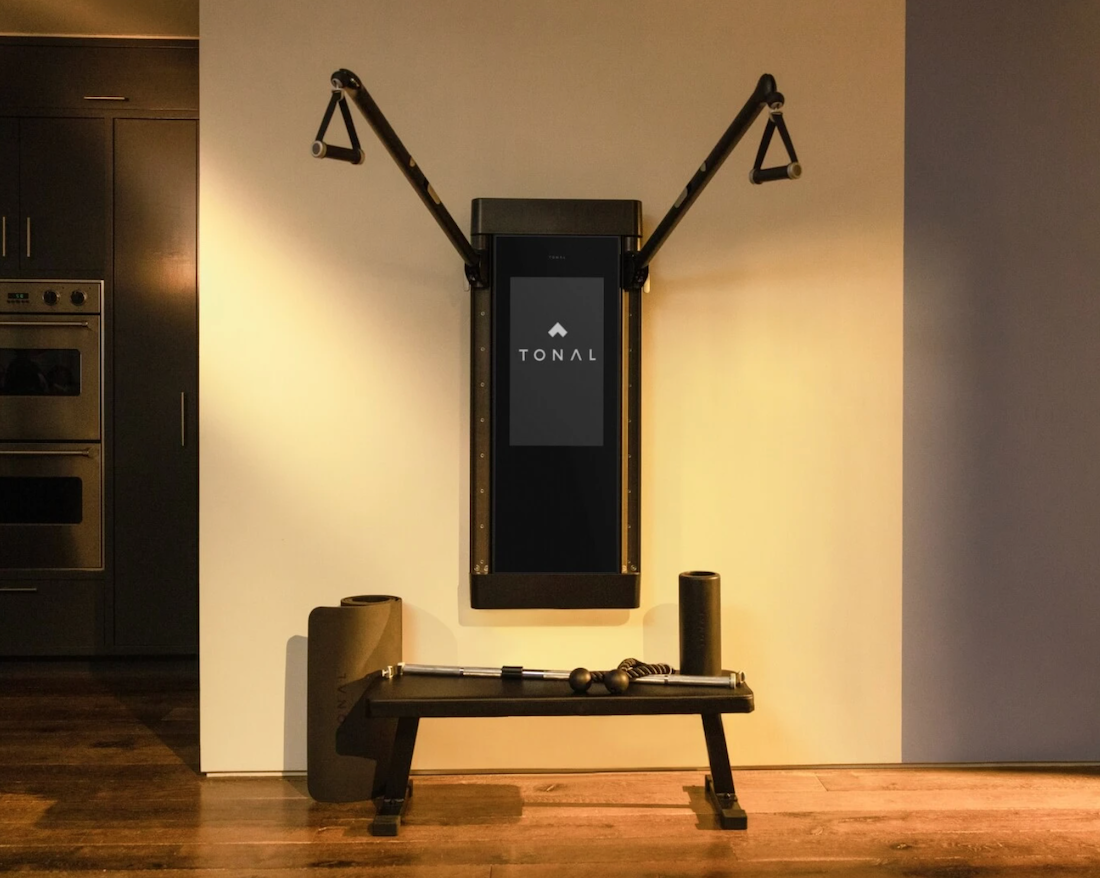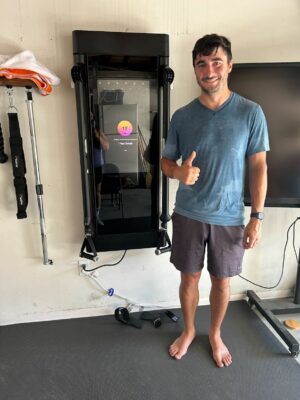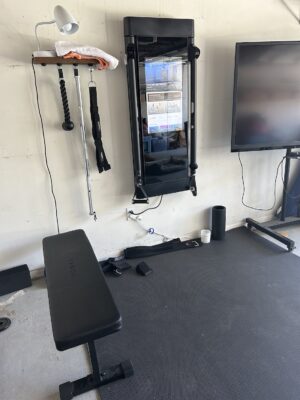
But that was a year ago. Up until we sat down recently to talk about how a year of working out with Tonal was going, we’d both pretty much forgotten all about the original challenge. Yet the Tonal has actually changed his workout habits, and, more broadly, the way he lives his life.
My fitness regimen? Not so much. I use Tonal about twice a week, the same amount I did bodyweight and dumbbell strength before I got it. But Ryan has gone from not working out at all pre-pandemic, to doing a virtual HIIT class maybe once a week for the first couple pandemic years, to getting exercise every single day.
“After I work out I’m much more of an alert, aware person,” he says. “I definitely feel a lot healthier. I definitely feel stronger.”
Photo: Rachel Kraus
What’s with the uneven results of our experiment? I sat down for an interview with, yes, my husband, to find out. It all comes down to convenience and motivation.
What is Tonal?
Tonal is kind of like a combination between a smart virtual fitness system like the Mirror, and a cable weight system, like a Bowflex, but all packed into one narrow wall-mounted unit. There is a screen in the middle, and two arms come out on either side that you can move up and down, in and out, and put at a downward angle, upward angle, or parallel to the floor. This adjustability and different handle attachments (including handles, a bar, and a rope) let you do pretty much any strength move, barring a racked squat that you rest on your shoulders (which you’re not supposed to do for safety reasons). The weight you lift comes from an electromagnetic resistance system inside the machine, so there are no bulky weights. You can use the Tonal in free-weight mode, or follow along in strength training classes where an instructor guides you through a series of moves.
Tonal comes with a library of content that includes strength, barre, dance, yoga, Pilates, and more. So it’s really designed to be an all-in-one fitness solution, but strength training is what sets it apart. It’s able to treat strength like any other at-home instructor-led fitness modality, like spinning or Pilates, with the benefit that you have all the equipment you need at your disposal. That’s useful both in that it makes weight training a little more fun and less of a solitary experience, and that it actually instructs you on how to strength train. That combo is what works for Ryan.
“When I went to the gym, I never really knew exactly what to do, and I like the structure of fitness classes,” he told me. “Structuring all your workouts for you without having to think is extremely appealing.”

Tonal — $4,490.00
The Tonal is a compact home gym with smart, progressive strength-training programs and ability to do nearly every strength-training move.
- Convenient
- Space-efficient
- Contains a variety of workout options
- Allows you to have multiple user profiles
- Smart features make progressive strength-training a breeze
- Fun stat tracking
- It’s expensive—the Tonal has a $3,995 base price, plus $495 for smart accessories bundle (which you really do need). Plus, you’ll pay a $59 monthly membership, which is required for the first year.
- Weight suggestions sometimes cause you to sacrifice form
- Potentially uncertain future of an independent company
You can do one-off classes, or you can join a program that serves up training sessions on a schedule. Programs are multi-week series that are all about progressive weight training. So you’ll do the same two or three sets of exercises week after week, but the weight or reps will increase over time.
I’ve tried a few programs myself, but the high cadence and the fact that I like to do free weight mode in addition to the classes typically makes me fall behind—which makes me not so great at actually finishing programs. Meanwhile, Ryan’s completed 12 in the last year, which comes out to about one four-week program every month. Do the math—that is consistent as heck. He says the fact that you’re both optimizing to build muscle through repetition, and the fact that you get to switch things up every month, is what works for him.
“I know it’s good for your body to do repetition of the same workouts on a week-to-week basis, so you actually see scaling improvement,” Ryan says. “But I tend to get bored of doing the same thing too much, which is why [programs] work really well for me.”
The key to Tonal’s progressive strength training is its smart weight assignments. Tonal “knows” how much weight to put on each arm for each exercise you do because it’s supposedly able to gauge when you’re struggling or when you can take on a little more based on your cadence and the resistance you’re giving back to the machine.
Not having to pick your weights is convenient, and certainly forces you to try things you might not otherwise. But it also has some downsides for me. I have a finicky lower back. So even if my lower body strength is capable of single-leg deadlifting 25 pounds—as Tonal knows from all the other exercises I do on it—that much weight for a position that requires perfect form in order to protect my lower back is actually too much for me. You can lessen the amount of weight manually, but sometimes, by the time I’ve realized a weight was too heavy (and, let’s be honest, pushed through some pain in order to get the achievement of finishing a set), my back is already kaput. Ryan and I have both also noticed that your form can suffer when Tonal assigns you a challenging weight—but that’s true of all strength training.
Your starting point comes from an initial strength assessment, where you do a series of exercises to gauge your strength baseline. From that, Tonal gives you an all-around “strength score,” and also scores for your upper and lower body and core, based on how your strength compares to other Tonal users. The number is pretty arbitrary, but you’re able to watch it tick up and up as you get stronger.
That digital weight also comes with nifty features that change the resistance as you’re doing a move. So, if you do an exercise in “eccentric mode,” the weight will increase when your muscle lengthens. This is how Tonal has implemented the principles of eccentric strength training, which has been shown to be an efficient way to build muscle. “Burnout mode” lets Tonal know when you’re struggling with a weight so that you can finish a set once you’ve reached muscle failure.
“You want to burn out, you want to get to failure,” Ryan says. “That’s what hypertrophy is supposed to do, that’s how it’s supposed to work, so you don’t really want it to be easy.”
I observed to Ryan that he would never have said the words “hypertrophy” or “burnout” to me in relation to building muscle a year ago. What’s the source of this newfound knowledge? Tonal.
Okay, will Tonal really make you work out more?
Simply put, having a full home gym, complete with basically a personal training system, is super convenient. And if a barrier to your working out is having to leave your house or having to decide what to actually do, Tonal takes care of that.
“One of my biggest reasons for stopping going to the gym in the past has always just been, I don’t want to get up and physically go there, because I just lose motivation to do that,” Ryan says. With Tonal, it’s easy to show up, and when you do “you get told what to do and you have no choice but to do it.”
That’s caused a corner of our garage to transform into Tonal central. Ryan built a shelf with 3D-printed hooks to hold the different attachments, and we have accumulated more Tonal attachments and accessories (like an alternative rope) thanks to recommendations from online Tonal communities, including Reddit and one Facebook group called “Tonal Dads.”
Photo: Rachel Kraus
The convenience has been a pull for me, too. While I consistently strength trained before Tonal entered our garage, it’s even easier to stick to that twice-a-week standard I set myself. And on days when I’m not really sure what I want to do for exercise, and maybe I’m feeling a little tired, too, I’ll sometimes just browse the full catalog of classes and choose a recovery workout or yoga.
Still, convenience is not what drives me when it comes to fitness. I like going to a class with other people once a week, or going for a run, and giving myself days when I just go for a walk. I like to intuit what I’m in the mood for, and something I can do in the garage with a pre-recorded trainer is not always the answer.
Tonal is not always how Ryan opts to work out, either: He Tonals, plays pickleball, or plays golf. Our workout mix is just different, and strength training three, four, or five times a week is what works for him—he likes seeing how Tonal has actually changed his muscle composition.
So Tonal gets a lot of credit for Ryan’s lifestyle change, but not all of it. The thing that he says compels him, and has kept him Tonaling week after week for a whole year, is “gamification.” (Which provides a clue as to why Tonal did not have the same transformative effect on my fitness habits.)
See, Ryan got an Apple Watch around the same time as we got a Tonal. So the combination of the ring closing from Apple and the stats he gets from Tonal are a big part of what drives him to hit the digital gym most days.
“The Apple watch works really well for my gamified brain because I like having a thing to finish every day,” Ryan says. “And then Tonal’s automatic stat tracking—its strength score, streak counting, and badges that are just like there for you to continuously earn—that works really well for my brain as motivation, too.”
It’s a positive feedback loop. Tonal allows Ryan to easily close his rings, which puts him on a streak, which makes him motivated to get some form of exercise every day.
“I think if I didn’t have the consistent thing at home being Tonal on any random day to be able to do it, I probably would just not complete the rings enough to think it’s even possible to do every day,” Ryan says. “I needed something at home to do every day that wasn’t just like a HIIT class. I would have burned out on that.”
Closing my rings has never captured my attention, and sometimes when I see badges in fitness apps—you know, the little digital buttons that you’ll get for doing a workout on a holiday, or for completing a month-long streak, or some such thing—I wonder, “Who are these badges for?”
It turns out the answer is: My husband. Cut to New Years Day 2023, with Ryan insisting we go home between a brunch and yet another party so that he could get his workout in, to get his New Year’s Day badge.
I look at my Tonal stats, too, and it’s fun to see how my strength score has gone up. But it just doesn’t seem to have the same pull on me as it does on Ryan. Meanwhile, Ryan has enjoyed seeing how many workouts he’s done, how many programs he’s completed, how much his strength score has gone up (105 percent), and other stats. At the end of the year, Tonal also tells you how much weight you’ve lifted.
Last year it told him that he’d lifted the equivalent of a large boat. “And I only had it for half of last year and I had lifted around a million pounds,” he points out. “This year I will expect to lift around 2 million. I’m excited to see what large item that equates to.”
Whatever works, babe. Whatever works.
Bottom line: Is Tonal worth it?
If you don’t enjoy going to a gym and devising your own workouts, the prospect of Tonal is great. It’s space-efficient, convenient, personalized, and comes with a lot of workout variety. But all of that smart technology and content comes with a hefty price tag. The base price is $3,995, plus $495 for smart accessories, which you really do need (this includes a bench, the rope, the barbell, and a button to turn the weight on and off). Plus, that price does not include the Tonal membership, which costs $59 per month. Tonal does have financing options, and it might be worth doing an audit to see how much you’d otherwise spend on gym memberships, equipment, and classes. But an annual price of $5,698 for the first year, and then, $708 every year thereafter, is not an easy pill to swallow.
Considering your future years with Tonal should also be top of mind when making this sort of investment. Tonal is an independent company that makes, repairs, and replaces its own machines, and produces its own content library. If anything happens to your machine, you need Tonal to be around to fix it! And you also need to bet on the Tonal production team consistently putting out new classes and programs. In late 2022, Tonal cut 35 percent of its staff, thanks to high operational costs and lower consumer demand for home gym equipment two-plus years after the start of the pandemic. When it raised its most recent round of capital, its valuation dropped from $1.9 billion in 2022 to $550–$600 million in spring 2023. Yet in April, Tonal told TechCrunch that it was on the way to becoming profitable. And rumors have been swirling for the past year about a Tonal 2.0 coming out. So the ship seems to be sailing smoother than it was last year, even if the waters are still a bit uncertain.
The investment might just be worth it if Tonal becomes your gym, your Pilates studio, your stretch leader, and your fitness teacher. The convenience can’t be beat, and the smart features make progressive strength training a mental (if not physical) breeze. My family’s year with Tonal has shown me that making this device the center of your fitness universe works better for some people than it does for others. The question of whether Tonal is worth it for you comes down to how much you like variety and working out alone inside vs. in a group or outside. And, of course, how badly do you want to know how much weight you lifted in a year? If gamification is the name of the game, then Tonal might have the winning formula.








